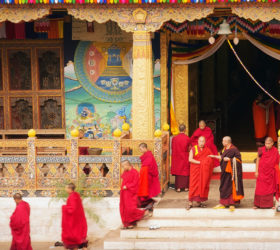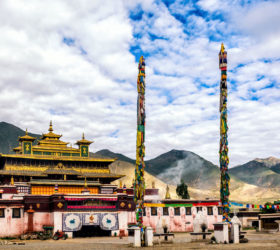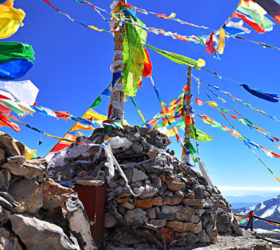Exploring Tibet
- China
- 23 Days
- Kunming | Lijiang | Gyalthang | Shating | Litang | Batang | Markham | Chamdo | Derge | Ganze | Dzogchen | Amdo | Kokonor | Xining
- The grand complex of Angkor Wat
- Khmer styled architecture in Bangkok
- The lively city of Yangon
- Private boat tour at Inle Lake
- Hotair balloon ride over Bagan
- 150 years old U Bein teak bridge at Mandalay
- China’s highest peak, Minya Konka at 24,783 feet
- Shangri-La
- Derge Gongchen Monastery
- Kokonor Lake
Overview
The image of Tibet is gloriously barren and intriguing. Visit to unravel the enigma in the country’s little-visited, mysterious eastern provinces of Kham, home of the legendary Khampa warriors, the Dalai Lama’s escorts in his valiant escape to India in 1959. After flying to Yunnan Province’s metropolis of Kunming, fly up to Lijiang and Gyalthang to spend a couple of easy days acclimating to the higher elevations. Then drive on a spectacular roller-coaster road up to Kham’s alpine pasturelands, passing just west of China’s highest peak, Minya Konka (or Gongga Shan; 24,783 feet). Wend our way through deep gorges and over high ridges to access some of the most remote valleys in the world.
En route, visit the historic monasteries of Chamdo, on the uppermost reaches of the Mekong River, and Derge, the cultural heart of Kham and the most influential of its five old kingdoms (the most authoritative texts of the Tibetan Buddhist canon was produced in Derge’s famous printing presses). Crossing the Tro La (pass), reach the market town of Ganze, famous as well for its thriving monastery, before heading north Amdo and up to Xining.
Itinerary
1
2
4
5
6
7
8
10
11
12
At Pomda Junction, our route turns north toward the Tibetan town of Chamdo (chamdo is the Tibetan word for “confluence of rivers”). Chamdo was one of the earliest centers of population in the region. It also became an important stronghold of the Karma Kargyu sect prior to its fall in 1950. The monastery of Galden Jampaling was founded by Tsongkhapas’ student, and has 700 monks reside in the renovated buildings and the present incarnation of Phakpalha, Gelek Namgyel lives in Lhasa. Visit the monastery at Chamdo, explore the town and the market in the old heart of this border town. The old town (the traditionally Tibetan section), with it’s many silver workshops, is still authentic and worth wandering around.
14
15
Here Sakya scholars printed their own edition of the Kyangur and Tanjur, regarded by many as the most accurate in Tibet. We will explore the Derge Gongchen Monastery, which contains enormous images of the Buddhas and the printing press, where one can see the entire process from preparation of the paper and ink, to carving of the blocks and actual printing and collating of the texts. The magnificent building, with its original frescoes and exquisite images of Sakyamunis, is a joy to see.
16
17
18
Next day, we will reach Madoi , a small city in the upper reaches of the Yellow river. The Yellow river is the second longest river in China with a length of 5,464 km. Time permitting we may be able to go to the source of the Yellow river.
Amdo is Tibet’s northeastern province, and most of it was swallowed by the Chinese province of Qinghai in 1928. We will drive by and along the immensely deep red gorges of the Yellow River as they cut a sweeping gorge through Amdo.
We will continue on to our camp/guesthouse by Kokonor Lake, known as the “Western Sea” in ancient times. This salt-water lake is China’s largest lake and the breeding ground of many migratory birds of which the rare black-necked crane get top billing.
22
23
| November – February: | Winter months, recommended to travel. |
| March – June: | Summer months, when it is is moderately hot in April, but May and June are avoidable. |
| July – September: | Monsoon months where trips are doable. |





